I am the original creator of this article and the original published article can be found here.

Initial Coin Offerings have been all the rage in 2017 as the infantile method of raising business capital grows exponentially across the globe — crowdfunding with cryptocurrency, I like to consider it. So much so that government regulators are starting to really crackdown on the activity. First came China announcing the ban of ICO’s; then followed South Korea; and most recently a new SEC task force in the US with EU regulators following.
To put it into perspective, $3,409,168,576 has been raised on Kickstarter since 2009. Across all ICO’s recorded by CoinDesk for the 2017 year, $3,557,667,313 has been raised (as of 11/20/2017). If you have participated in an ICO, you already know you receive a token for your contribution as opposed to physical goods as a reward as seen on Kickstarter. Most individuals contributing to an ICO are investors and expect a financial return for their contribution. So why are investors so hyped about the ICO projects raising so much capital ($50,000,000+)? Should investors instead seek ‘hidden gem’ projects with low market caps?
More Capital, Better Chance of Success — Myth.
There have been a number of blockchain projects advertising the fact that they successfully raised millions of dollars in the pre-slae or first few days of the ICO as the campaign continues running. The number of ICO’s launching in 2017 have exponentially risen, in turn, making it harder for the ‘less-equipped’ to raise large sums of capital. It becomes harder to raise because as time passes the amount of capital investors have to invest shrinks in comparison to the amount of combined capital all ICO projects are aiming to raise. More capital raised might not be the best statistic for investors to look for as an indicator of a potentially more successful project.

CoinTelegraph: ‘Second Suit Filed As Tezos Woes Continue’
According to CoinSchedule, the Tezos ICO raised $232,319,985. Wow, how could a project that has raised hundreds of millions fail? Well, the Tezos leadership could not get along and have now been hit with their 2nd class action lawsuit from investors who contributed to their ICO…that will without a question hurt the value of Tezos if not completely destroy it as the drama unravels. What type of return were investors expecting with that much capital raised anyway? Tezos issued 763,306,929.69 tokens (20% locked in vesting contracts). That means 610,645,543.752 tokens are circulating. What do the returns look like for ICO investors? Let’s compare Tezos and the recent Genesis Vision ICO which aimed to raise $33m, but reached just $2,836,724. Despite raising less than expected, Genesis Vision may have the upper-hand when providing ICO investors’ a return.
Below is an example of post-ICO performance of two projects that raised drastically different levels of capital (11/22/2017):
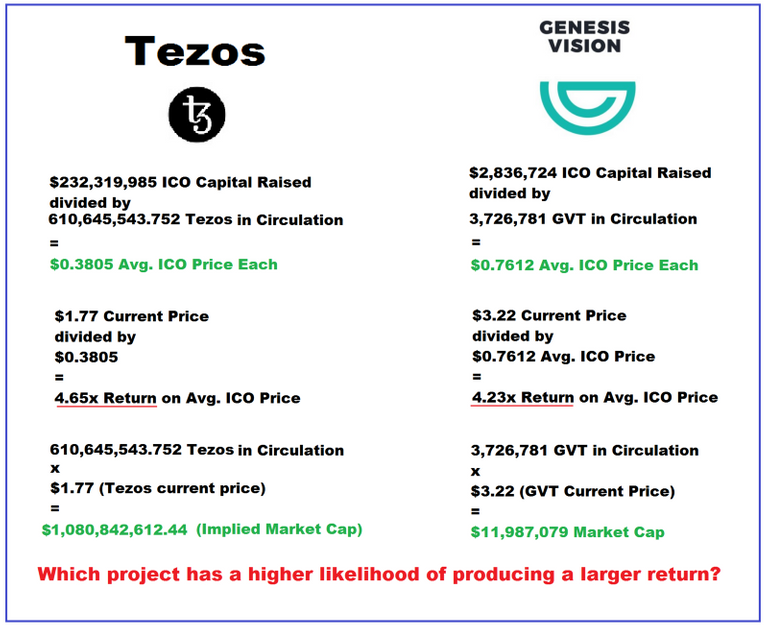
Looking at the image above, we can see that both Tezos and Genesis Vision, to date, have provided their ICO investors very similar levels of ROI; however, Tezos raised over 80x more capital than Genesis Vision. Despite raising less capital, Genesis Vision has a much better chance of providing their investors with an even larger return. Let’s look into why below.
Why Seeking ‘Hidden Gem’ ICO’s is Powerful
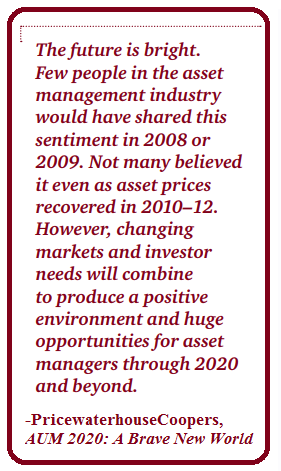
[‘Investor Trust in the Asset Under Management (AUM) Market, Can Blockchain Help?’](‘Investor Trust in the Asset Under Management (AUM) Market, Can Blockchain Help?’)
I like to call superior projects who raise less capital than expected ‘hidden gems’ because they are less known, but have the potential to provide godly returns we don’t even see in traditional stock market investing. Most active cryptocurrency traders understand that blockchain technology is brand new and opening the world up to unknown possibilities. With an overall market capitalization $244,866,250,516, the cryptocurrency market cap is dwarfed by various already established markets such as the $71,000,000,000,000 Assets Under Management (AUM) market — yes, those are trillions. PricewaterhouseCoopers expects it to reach $101 trillion by 2020 and is ripe for disruption. Genesis Vision has the potential to ‘unlock’ that $71 trillion market and, just like drinking from a straw, cause that institutional capital to flow into the cryptocurrency market.
Focusing on market capitalization, let’s take a look at hypothetical returns to Tezos and Genesis Vision ICO investors:
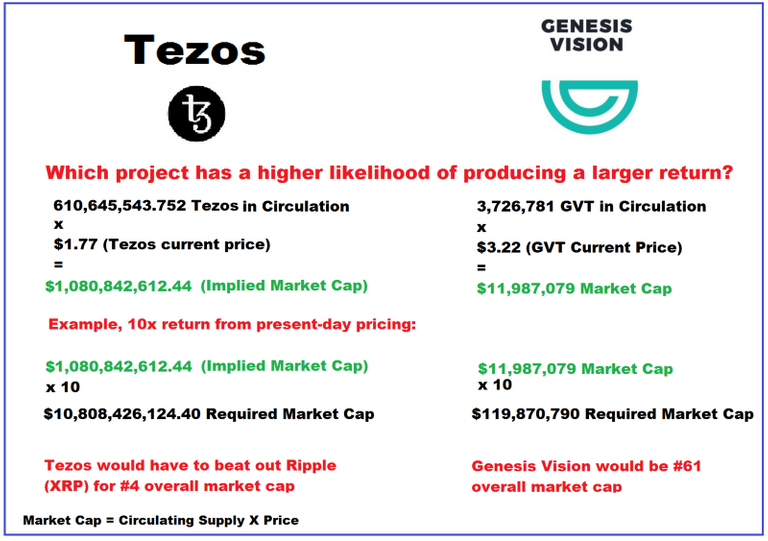
Market cap is a great indicator for investors to use to gain a better understanding of the project size and growth potential. Think Ethereum’s $39 billion market cap versus NEO’s $2.4 billion market cap — NEO’s market cap is just a fraction of Ethereum’s, giving us an idea of it’s growth potential considering they are competing blockchains. If NEO aims to accomplish similar feats, then we have an idea of where the price could go from here by looking at current market cap.
Looking at the chart above, Tezos would need to reach a market cap of over $10 billion in order to return 10x from where they are now, a market cap the institutionally-supported Ripple is having trouble surpassing. At the same time, there are 60 cryptocurrency projects with under $120 million market cap. Since market cap is equal to the circulating supply multiplied by price, it becomes increasingly obvious that the Genesis Vision project is much more likely to provide investors with another post-ICO 10x return than the Tezos project, so long as growing the market cap is a focus.
Not A Stock, But Still A Speculative Insutrument
While the Genesis Vision Token is not considered a financial security per their announcement, but it is still a speculative instrument gaining and losing value minute-to-minute based on speculation, similar to a stock. The ICO and IPO become almost synonymous when it comes to investor returns — the token is liquid and can be traded on an exchange at prices determined by investors on the exchange — just like a stock on the stock market.
While the companies in the chart above are the dominating tech companies of today and much larger than the Tezos and Genesis Vision ICO’s, they all had very different results when going public. We can see that even Facebook traded below it’s IPO price for 15-months, when IPO investors could finally realize a profit. At the same time, Google was trading above IPO price since going public and continued to flourish, providing the IPO investors a near 19x return to date.
Why might explain this difference in IPO investor returns between the large tech giants?
I think we can all agree that Google had a major competitive advantage at the time of it’s IPO in 2004 compared to the other tech companies at the time of their IPO’s. Google focused heavily on building the internet infrastructure the other tech companies would utilize today. Plus, Facebook and Twitter were already competing with various social media companies and Groupon had a major core problem with their business model (‘fatty’ sales team), causing them to spend far too much on human labor, taking away from IPO returns.
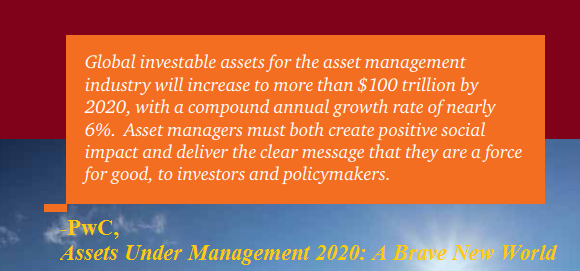
‘Investor Trust in the Asset Under Management (AUM) Market, Can Blockchain Help?’
The main point I want to get across using these charts is that raising a large sum of capital does not always have a direct positive impact on the returns provided to investors. Facebook and Twitter were both social media giants at the time of their IPO — FB raising 8x that of Twitter. Despite raising less capital, Twitter was able to provide IPO investors with an immediate post-IPO return while Facebook took 15-months to provide their IPO investors a return. Obviously raising more capital did not give their investors a larger return any sooner. At the same time, Google’s innovative business model and fair sum of capital raised (and/or efficient spending) allowed them to create excessive value from the beginning of their IPO, reflecting in their stock price over time.
‘Hidden Gems’ Solve Problems & Create Real Value
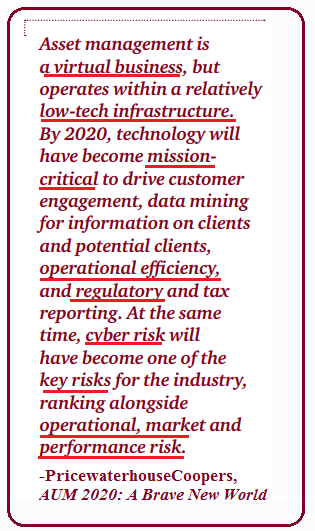
‘Investor Trust in the Asset Under Management (AUM) Market, Can Blockchain Help?’
Not to shill for Genesis Vision, but it is my definition of a truly ‘hidden gem’ as:
- their project has already provided ICO investors with a 4x return;
- has plenty more room for growth in their market cap with the potential to provide another 10x returns and up to 100x+; and
- a business model that focuses on relieving very specific pain points in a $71 trillion AUM market, using the GVT to capture and retain value in their own ecosystem.
Investing in an ICO project which raised hundreds of millions of dollars with intention of receiving a larger return than a smaller project is a misconception ICO investors may want to start re-thinking considering the numbers above. Just because a project raises $50m+ does not make them successful automatically — if anything, it can give them more money than they know what to do with. Tezos may have provided their investors with an immediate post-ICO return, but it is obvious there were bigger problems within their leadership team.
Hidden gems are not easy to find as they are not as widespread as the larger projects, but still have a quality business model at the core and solves real-world problems. Which hidden gems have you found most exciting in your time investing in cryptocurrency?
Below are resources for cryptocurrency traders:
Below are some resources for beginning cryptocurrency enthusiasts:
- HitBTC Exchange — major exchange, access ICOs on the exchange
- CoinTracking — Your personal Profit / Loss Portfolio Monitor and Tax Tracker for all Digital Coins
- CoinMate.io — Exchange cryptocurrency for crytocurrency
- Binance Exchange— the up-and-coming cryptocurrency exchange that has truly entered as a leader among exchanges. Tons of benefits, a trader’s must-see.
- CEX.io — one of the better crypto-4-crypto exchanges
- Kucoin Exchange - competitor to Binance and they have their own token as well, giving holders 50% of revenue daily.
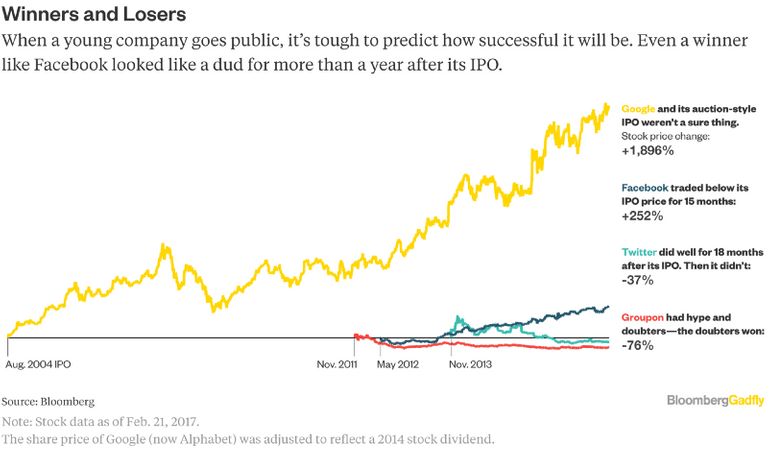
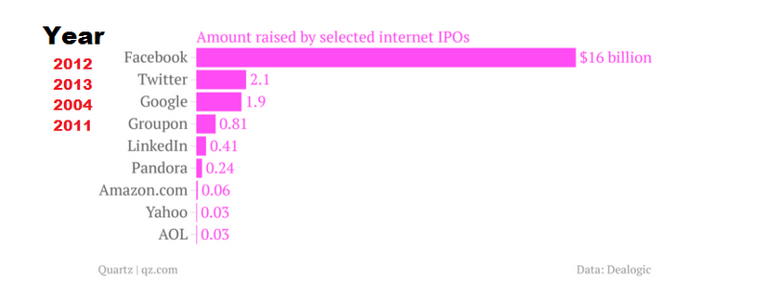
While it may not be a scam in your opinion, it could be considered spam. Spam is not appreciated by the community and could be flagged or may result in action from the cheetah bot..
Some things that can be considered spam:
We are not allowed to put referral links into articles?
This is definitely not spam either. Once again, I even included where the article was originally published and that I am the original author. My Medium account even has a link to my Steemit account in it. Please quit flagging my posts. There's nothing wrong with posting the same content on multiple blog platforms so long as I give myself credit where credit is due...this is MY content and I am not spamming.
Thank you in advance.